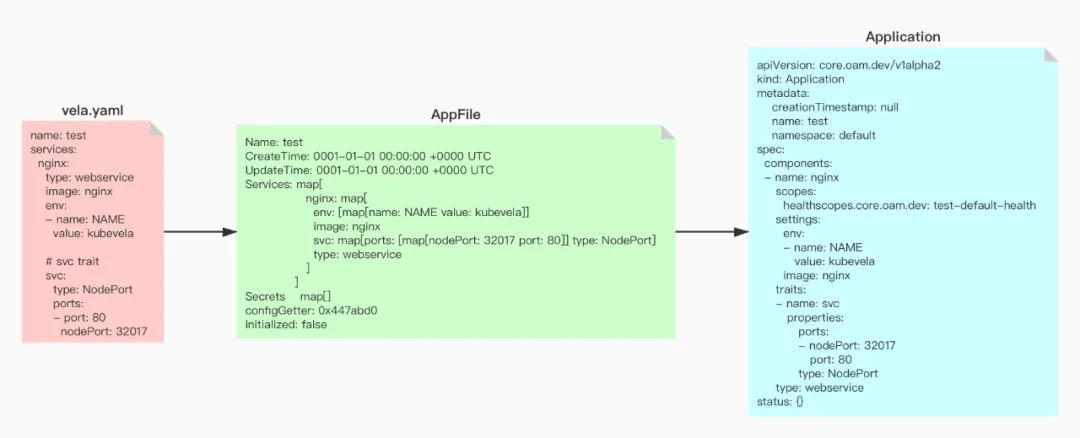
源码解读:KubeVela 是如何将 appfile 转换为 K8s 特定资源对象的
执行 vela up 命令,渲染 appfile 为 Application,将数据写入到 .vela/deploy.yaml 中,并在 K8s 中创建。Application 是如何转换为对应 K8s 资源对象起点:Application中点:ApplicationConfiguration, Component终点:Deployment, Service路径:【建议】> 了解一下内容:> -
该过程总的来说分为两个阶段:
-
appfile 转为 K8s 中的 application
-
application 转换为对应的 K8s 资源对象
vela.yaml
name: test
services:
nginx:
type: webservice
image: nginx
env:
- name: NAME
value: kubevela
svc trait
svc:
type: NodePort
ports:
- port: 80
nodePort: 32017
利用 vela up 命令可以完成部署。
===============================================================================
建议:在看 vela 命令行工具代码之前,先去简单了解一下 cobra 框架。
// references/cli/up.go
// NewUpCommand will create command for applying an AppFile
func NewUpCommand(c types.Args, ioStream cmdutil.IOStreams) *cobra.Command {
cmd := &cobra.Command{
Use: “up”,
DisableFlagsInUseLine: true,
Short: “Apply an appfile”,
Long: “Apply an appfile”,
Annotations: map[string]string{
types.TagCommandType: types.TypeStart,
},
PersistentPreRunE: func(cmd *cobra.Command, args []string) error {
return c.SetConfig()
},
RunE: func(cmd *cobra.Command, args []string) error {
velaEnv, err := GetEnv(cmd)
if err != nil {
return err
}
kubecli, err := c.GetClient()
if err != nil {
return err
}
o := &common.AppfileOptions{
Kubecli: kubecli,
IO: ioStream,
Env: velaEnv,
}
filePath, err := cmd.Flags().GetString(appFilePath)
if err != nil {
return err
}
return o.Run(filePath, velaEnv.Namespace, c)
},
}
cmd.SetOut(ioStream.Out)
cmd.Flags().StringP(appFilePath, “f”, “”, “specify file path for appfile”)
return cmd
}
上面源码展示的是 vela up 命令的入口。
在 PresistentPreRunE 函数中,通过调用 c.SetConfig() 完成 Kuberentes 配置信息 kubeconfig 的注入。
在 RunE 函数中:
-
首先,获取 vela 的 env 变量,velaEnv.Namespace 对应 Kubernetes 的命名空间。
-
其次,获取 Kubernetes 的客户端,kubectl。
-
接着,利用 Kubernetes 客户端和 vleaEnv 来构建渲染 Appfile 需要的 AppfileOptions。
-
最后,调用 o.Run(filePath, velaEnv.Namespace, c)。
-
该函数需要三个参数,其中 filePath 用于指定 appfile 的位置,velaEnv.Namespace 和 c 用来将渲染后的 Application 创建到指定命名空间。
-
filePath: appfile 的路径
-
velaEnv.Namespace:对应 K8s 的 namespace
-
c:K8s 客户端
如何将一个 appfile 转为 Kubernetes 中的 Application
===============================================================================================================
-
起点:appfile
-
终点:applicatioin
-
路径:appfile -> application (services -> component)
-
comp[workload, traits]
1. 起点:AppFile
// references/appfile/api/appfile.go
// AppFile defines the spec of KubeVela Appfile
type AppFile struct {
Name string json:"name"
CreateTime time.Time json:"createTime,omitempty"
UpdateTime time.Time json:"updateTime,omitempty"
Services map[string]Service json:"services"
Secrets map[string]string json:"secrets,omitempty"
configGetter config.Store
initialized bool
}
// NewAppFile init an empty AppFile struct
func NewAppFile() *AppFile {
return &AppFile{
Services: make(map[string]Service),
Secrets: make(map[string]string),
configGetter: &config.Local{},
}
}
// references/appfile/api/service.go
// Service defines the service spec for AppFile, it will contain all related information including OAM component, traits, source to image, etc…
type Service map[string]interface{}
上面两段代码是 AppFile 在客户端的声明,vela 会将指定路径的 yaml 文件读取后,赋值给一个 AppFile。
// references/appfile/api/appfile.go
// LoadFromFile will read the file and load the AppFile struct
func LoadFromFile(filename string) (*AppFile, error) {
b, err := ioutil.ReadFile(filepath.Clean(filename))
if err != nil {
return nil, err
}
af := NewAppFile()
// Add JSON format appfile support
ext := filepath.Ext(filename)
switch ext {
case “.yaml”, “.yml”:
err = yaml.Unmarshal(b, af)
case “.json”:
af, err = JSONToYaml(b, af)
default:
if json.Valid(b) {
af, err = JSONToYaml(b, af)
} else {
err = yaml.Unmarshal(b, af)
}
}
if err != nil {
return nil, err
}
return af, nil
}
下面为读取 vela.yaml 文件后,加载到 AppFile 中的数据:
vela.yaml
name: test
services:
nginx:
type: webservice
image: nginx
env:
- name: NAME
value: kubevela
svc trait
svc:
type: NodePort
ports:
- port: 80
nodePort: 32017
Name: test
CreateTime: 0001-01-01 00:00:00 +0000 UTC
UpdateTime: 0001-01-01 00:00:00 +0000 UTC
Services: map[
nginx: map[
env: [map[name: NAME value: kubevela]]
image: nginx
svc: map[ports: [map[nodePort: 32017 port: 80]] type: NodePort]
type: webservice
]
]
Secrets map[]
configGetter: 0x447abd0
initialized: false
2. 终点:application
// apis/core.oam.dev/application_types.go
type Application struct {
metav1.TypeMeta json:",inline"
metav1.ObjectMeta json:"metadata,omitempty"
Spec ApplicationSpec json:"spec,omitempty"
Status AppStatus json:"status,omitempty"
}
// ApplicationSpec is the spec of Application
type ApplicationSpec struct {
Components []ApplicationComponent json:"components"
// TODO(wonderflow): we should have application level scopes supported here
// RolloutPlan is the details on how to rollout the resources
// The controller simply replace the old resources with the new one if there is no rollout plan involved
// +optional
RolloutPlan *v1alpha1.RolloutPlan json:"rolloutPlan,omitempty"
}
上面代码,为 Application 的声明,结合 .vela/deploy.yaml(见下面代码),可以看出,要将一个 AppFile 渲染为 Application 主要就是将 AppFile 的 Services 转化为 Application 的 Components。
.vela/deploy.yaml
apiVersion: core.oam.dev/v1alpha2
kind: Application
metadata:
creationTimestamp: null
name: test
namespace: default
spec:
components:
- name: nginx
scopes:
healthscopes.core.oam.dev: test-default-health
settings:
env:
- name: NAME
value: kubevela
image: nginx
traits:
- name: svc
properties:
ports:
- nodePort: 32017
port: 80
type: NodePort
type: webservice
status: {}
3. 路径:Services -> Components
结合以上内容可以看出,将 Appfile 转化为 Application 主要是将 Services 渲染为 Components。
// references/appfile/api/appfile.go
// BuildOAMApplication renders Appfile into Application, Scopes and other K8s Resources.
func (app *AppFile) BuildOAMApplication(env *types.EnvMeta, io cmdutil.IOStreams, tm template.Manager, silence bool) (*v1alpha2.Application, []oam.Object, error) {
…
servApp := new(v1alpha2.Application)
servApp.SetNamespace(env.Namespace)
servApp.SetName(app.Name)
servApp.Spec.Components = []v1alpha2.ApplicationComponent{}
for serviceName, svc := range app.GetServices() {
…
// 完成 Service 到 Component 的转化
comp, err := svc.RenderServiceToApplicationComponent(tm, serviceName)
if err != nil {
return nil, nil, err
}
servApp.Spec.Components = append(servApp.Spec.Components, comp)
}
servApp.SetGroupVersionKind(v1alpha2.SchemeGroupVersion.WithKind(“Application”))
auxiliaryObjects = append(auxiliaryObjects, addDefaultHealthScopeToApplication(servApp))
return servApp, auxiliaryObjects, nil
}
上面的代码是 vela 将 Appfile 转化为 Application 代码实现的位置。其中 comp, err := svc.RenderServiceToApplicationComponent(tm, serviceName) 完成 Service 到 Component 的转化。
// references/appfile/api/service.go
// RenderServiceToApplicationComponent render all capabilities of a service to CUE values to KubeVela Application.
func (s Service) RenderServiceToApplicationComponent(tm template.Manager, serviceName string) (v1alpha2.ApplicationComponent, error) {
// sort out configs by workload/trait
workloadKeys := map[string]interface{}{}
var traits []v1alpha2.ApplicationTrait
wtype := s.GetType()
comp := v1alpha2.ApplicationComponent{
Name: serviceName,
WorkloadType: wtype,
}
for k, v := range s.GetApplicationConfig() {
// 判断是否为 trait
if tm.IsTrait(k) {
trait := v1alpha2.ApplicationTrait{
Name: k,
}
…
// 如果是 triat 加入 traits 中
traits = append(traits, trait)
continue
}
workloadKeys[k] = v
}
// Handle workloadKeys to settings
settings := &runtime.RawExte nsion{}
pt, err := json.Marshal(workloadKeys)
if err != nil {
return comp, err
}
if err := settings.UnmarshalJSON(pt); err != nil {
return comp, err
}
comp.Settings = *settings
if len(traits) > 0 {
comp.Traits = traits
}
return comp, nil
}
4. 总结
执行 vela up 命令,渲染 appfile 为 Application,将数据写入到 .vela/deploy.yaml 中,并在 K8s 中创建。

==================================================================================================
-
起点:Application
-
中点:ApplicationConfiguration, Component
-
终点:Deployment, Service
-
路径:
-
application_controller
-
applicationconfiguration controller
【建议】> 了解一下内容:> - client-to
自我介绍一下,小编13年上海交大毕业,曾经在小公司待过,也去过华为、OPPO等大厂,18年进入阿里一直到现在。
深知大多数Java工程师,想要提升技能,往往是自己摸索成长或者是报班学习,但对于培训机构动则几千的学费,着实压力不小。自己不成体系的自学效果低效又漫长,而且极易碰到天花板技术停滞不前!
因此收集整理了一份《2024年Java开发全套学习资料》,初衷也很简单,就是希望能够帮助到想自学提升又不知道该从何学起的朋友,同时减轻大家的负担。


既有适合小白学习的零基础资料,也有适合3年以上经验的小伙伴深入学习提升的进阶课程,基本涵盖了95%以上Java开发知识点,真正体系化!
由于文件比较大,这里只是将部分目录截图出来,每个节点里面都包含大厂面经、学习笔记、源码讲义、实战项目、讲解视频,并且会持续更新!
如果你觉得这些内容对你有帮助,可以扫码获取!!(备注Java获取)

最后总结
ActiveMQ+Kafka+RabbitMQ学习笔记PDF




关于分布式,限流+缓存+缓存,这三大技术(包含:ZooKeeper+Nginx+MongoDB+memcached+Redis+ActiveMQ+Kafka+RabbitMQ)等等。这些相关的面试也好,还有手写以及学习的笔记PDF,都是啃透分布式技术必不可少的宝藏。以上的每一个专题每一个小分类都有相关的介绍,并且小编也已经将其整理成PDF啦
《互联网大厂面试真题解析、进阶开发核心学习笔记、全套讲解视频、实战项目源码讲义》点击传送门即可获取!
码讲义、实战项目、讲解视频,并且会持续更新!**
如果你觉得这些内容对你有帮助,可以扫码获取!!(备注Java获取)

最后总结
ActiveMQ+Kafka+RabbitMQ学习笔记PDF
[外链图片转存中…(img-tpDAdZq9-1713751727286)]
[外链图片转存中…(img-qYBQL4al-1713751727286)]
[外链图片转存中…(img-VXQbaZhL-1713751727287)]
[外链图片转存中…(img-i56UUlVq-1713751727287)]
关于分布式,限流+缓存+缓存,这三大技术(包含:ZooKeeper+Nginx+MongoDB+memcached+Redis+ActiveMQ+Kafka+RabbitMQ)等等。这些相关的面试也好,还有手写以及学习的笔记PDF,都是啃透分布式技术必不可少的宝藏。以上的每一个专题每一个小分类都有相关的介绍,并且小编也已经将其整理成PDF啦
《互联网大厂面试真题解析、进阶开发核心学习笔记、全套讲解视频、实战项目源码讲义》点击传送门即可获取!
更多推荐
 已为社区贡献3条内容
已为社区贡献3条内容






所有评论(0)